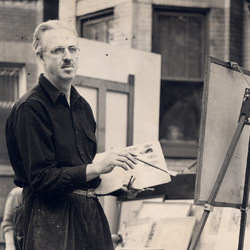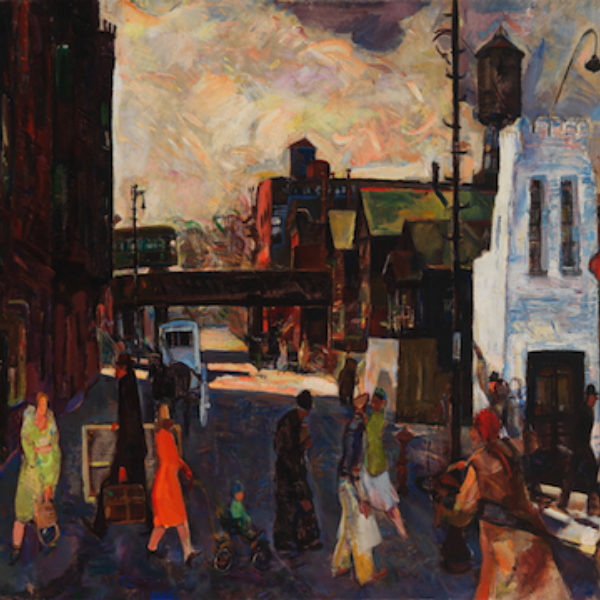
Francis Chapin
b. 1899, Bristolville, OH - d. 1965, Chicago, IL
Hailed as the Dean of Chicago Painters during his lifetime, Francis Chapin was well known for the lively, vibrant, and colorful landscapes, seascapes, and scenes of urban life he produced during his forty-year career as a painter. Chapin was born in Bristolville, Ohio, in 1899, and came to Chicago to study at the School of the Art Institute of Chicago (SAIC) after earning a BS degree at Washington and Jefferson College in Pennsylvania. When he enrolled in 1922, SAIC still maintained a conservative Beaux Arts pedagogy, stressing the importance of the human figure and privileging drawing over painting. But Chapin was also exposed to the New York artist Leon Kroll during his visiting professorship in 1925–26, tempering his traditional education with the commitment to freedom of expression that Kroll and his Ashcan School predecessors—George Bellows and Randall Davey, who also had visiting positions at SAIC several years earlier—emphasized to their students. By the time Chapin completed his graduate education in 1928, his work combined the superb technical skills valued by the school with the independence characteristic of the modernist approach to art stressed by Kroll. Indeed, what drew Chapin to Chicago initially may have been what he perceived as an opportunity to exercise his individuality. In 1950, he told Time magazine that “an artist had more chance to develop his own style” in Chicago than on the East Coast. Like so many of his Chicago contemporaries, Chapin was determined to express himself sincerely, in a style appropriate to his personal vision.
After a trip to Paris in 1928 made possible by the Bryan Lathrop Traveling Fellowship, he returned to Chicago and began a period of teaching at SAIC that continued until 1947. He studied with the renowned lithographer Bolton Brown, who was invited to teach at the school in 1930, and became an esteemed teacher of that subject himself, influencing such artists as Ivan Albright, with whom he developed a close relationship despite their diametrically opposed working styles. Albright, his twin Malvin, and numerous other artists and students, enjoyed the regular Saturday night gatherings at the Chapins (he married his first wife, Hildur, in 1932; after Hildur’s death he married Vivian in 1948) where discussions of the latest art was fueled with endless bowls of popcorn and beer.
During his tenure at the School of the Art Institute, he spent summers in Saugatuck, Michigan, directing and teaching at the Art Institute’s Ox Bow School. Although always based in Chicago, Chapin traveled widely, making a record of trips to such locales as Spain, Portugal, Italy, Mexico, and the American Southwest in paint. After 1947, he was a visiting artist at the University of Georgia, Stetson University in Florida, and the Museum of Fine Arts in Columbus, Georgia. He was an known internationally, having painted and exhibited in both Europe and Latin America and serving as an artist in residence at the American Academy in Rome in 1960–62; nationally, where his work was shown at the Museum of Modern Art, the Pennsylvania Academy, and the Whitney Museum of American Art; and locally, where he lived and worked, for most of his mature life, in a studio on Menominee Street in the Old Town neighborhood of Chicago.
Chapin rarely dated his work, making his development difficult to trace. His early work, consisting of dark, carefully painted oils with a fine finish reflective of his academic training gave way to the bright, loose, seemingly spontaneous painting of his maturity that is seen in White Tower, which won the Cahn Prize at the Art Institute of Chicago’s 44th Annual Exhibition of American Painting and Sculpture in 1931. It depicts the water tower, White Castle restaurant, low-rise buildings, and elevated tracks around the Old Town neighborhood where he made his home. The tall man with the canvas under his arm hurrying across the street is Chapin himself. White Tower is characterized by the bravura brushstrokes and dazzling colors that typify his work. In its emphasis on the virtues and pleasures of the small-town quality of the Old Town area with its bustling human activity, rather than on the sleek modernity of the skyscrapers of the city center, the work conforms to the American scene painting that was so popular at this time.
Susan Weininger
References
Messersmith, Fred. “Francis Chapin, an Exuberant Painter.” American Artist (March 1965), 62.
Weininger, Susan. “Francis Chapin.” In Chicago Modern: Pursuit of the New, 1890–1945, edited by Elizabeth Kennedy, 100. Chicago: Terra Museum of American Art, 2004.
Weininger, Susan. Francis Chapin. Chicago: Richard Norton Gallery, 2009.
Artist image: Photograph of Francis Chapin, June 1951, collection of Bernard Friedman.
